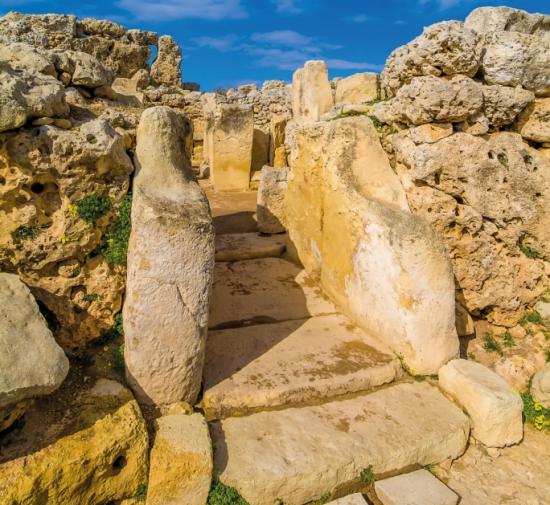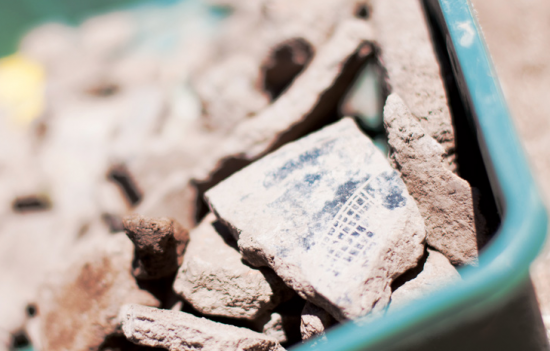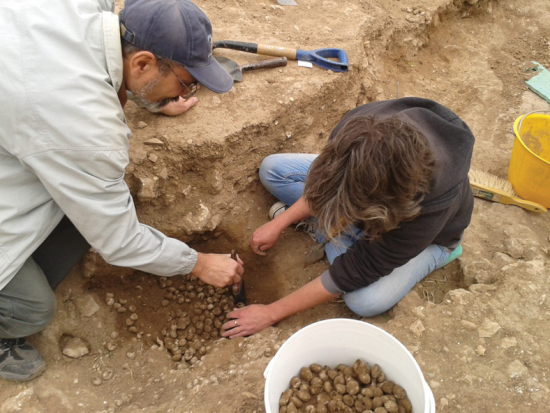Edward Duca / University of Malta
Source - http://www.um.edu.mt/think/the-death-of-the-temple-people/

Welcome to Malta’s largest archaeological attraction: the Temple Period. We have Maltese and British archaeologists to thank for this heritage that has been dug up since the early 20th century. Yet there are still unanswered questions why these people survived for so long then suddenly vanished. The FRAGSUS project—the largest international archaeological collaboration in Malta and Gozo—is trying to answer why.
Let us start on a journey. A journey back to a time when the Maltese population lived in Malta and Gozo with a cult obsessed with life and death. Symbols of sexuality were common, with many phallic shapes and fertile obese figurines strewn around the remains that have survived to the modern era.
Settlers from Sicily had arrived around one and a half millennia before this culture developed bringing goats, cows, sheep, crops, and quickly deforested the island. At some point over this time the population developed an obsession with temple building, and a complex culture around it, that only became more extreme as the civilisation flourished. ‘The Maltese Islands seem to have gone on a complete tangent from what was going on around them giving expression to the Temple Period which lasted for just over a millennium’, Dr Nicholas Vella (Department of Classics and Archaeology, University of Malta) said.

The Temple Period civilisation is famous for having built the oldest free- standing stone structures in the world. They covered Malta and Gozo with over 30 temple complexes over their 1100 year history. Apart from extensive temple sites cluttered with the evidence of complex rituals and animal sacrifices, intricate burial complexes were also built showing a deep respect for death.
During the Temple Period artwork flourished. Hundreds of statues have been discovered. Although famous for abundantly fertile ‘fat ladies’, these only make up around 15% of the statues found, with phallic and especially androgynous symbols being much more common. How the Islands managed to sustain such a rich culture is a mystery. Another mystery is how it all ended. The Temple people did not suffer from any obvious disease, lack of food, or invasion, at least that is the story the studies carried out until now tell us. One theory is that environmental stress and religious extremism somehow killed them off. The Temple people came and left, ‘we cannot find a successor,’ stated Prof. Anthony Bonanno (Department of Classics and Archaeology, University of Malta).
“Although famous for abundantly fertile ‘fat ladies’, these only make up around 15% of the statues found, with phallic and especially androgynous symbols being much more common”
A Light in the Darkness
In the early 20th century, Sir Themistocles Zammit’s unearthing of underground burial complexes—hypogea—with the adjoining megaliths of the Tarxien Temples solidified Malta’s identity with this stone architecture. Unfortunately, by the 1950s archaeology had lost its importance in Malta. The craze generated by Temi Zammit’s findings had long died out, and as independence rolled on in 1964 things just got worse culminating in Mintoff’s government that dissolved the whole Faculty of Arts at the University of Malta.
In those days, Bonanno was a lecturer with a lot of time on his hands. ‘I had very little teaching.’ So it came as a lifesaver when the Director of the Tourism Department approached him to organise a conference that, after approval from a new Rector, culminated in a conference in 1985 on Fertility Cults in the Mediterranean. At the conference, amateur archaeologist Joseph Attard Tabone showed how he thought he had rediscovered an ancient stone circle immortalised by Charles de Brocktorff’s watercolours.
Amazed by the revelation, world-leading archaeologist Colin Renfew was easily persuaded to organise a dig in Gozo. By 1987, the British were back with Dr David Trump, Prof. Caroline Malone (Queen’s University Belfast, back then Cambridge) and Dr Simon Stoddart (University of Cambridge) all digging alongside the Maltese team that included Bonanno, Dr Tancred Gouder (Museums Department), Vella (back then as a student), and others. A change in government that year reinstated the Faculty of Arts—archaeology was back in the picture.
The Brocktorff or Xagħra Stone Circle ‘was a lost site. We went there thinking, “we cannot do too much damage, let’s dig a hole in the ground” and it turned into very much more. Our original programme of five years was extended to seven. […] Babies were brought to the site. It has taken up a lot of our lives […] then we decided that that was the limit of our funding and energy,’ recollected Malone.
Seven years of digging and 220,000 bones from 800 individuals later, and they revealed ‘a great crater left by a collapsed cave, it had been a hypogeum. A natural hypogeum enhanced by megalithic monuments that probably lasted around 1500 years till 2500 BC as part of the Ġgantija complex.’ They had found an archaeological goldmine that helped train a new generation of archaeologists who are all now prominent in the field.
Squaring a Circle
Isotope and trace element analysis of the bones showed that they were healthy and mostly ate meat or vegetables
The Xagħra Stone circle was an extensive underground burial complex. Not as big as the hypogeum at Ħal Saflieni, that Sir Themistocles Zammit estimated housed around 6,000–7,000 individuals, but it revealed a civilisation whose complexity is unusual for its age and it took over a decade for the Anglo-Maltese team to compile extensive results from the digs.
The rituals of the burial practices changed greatly with time. At the early Żebbuġ Period between 4000–3500 BC the rock-cut or natural caves housed family units, one generation on top of the other. Bones seemed to have been pushed to the side to make space for the most recent burial. Several gifts were placed with the dead but no obvious human figurines.

After this time, the Temple Period flourished. The burial complex was extensively modified with the internal caverns extended and subdivided into rooms with many more enclosed spaces for burials for their complex death rituals. More communal burials seem to emerge with large pits housing hundreds of individuals whose bones have been separated, sorted, and stacked on top of each other. Grave gifts had transformed to the famous ‘fat ladies’ that are clearly female in this case. At ground level another grave-pit was found exclusively for male body parts without grave gifts, nodding towards a matriarchal society. It seemed that older burials were removed and body parts sorted into mass pits with newer burials placed in the compartmentalised caves or chambers.To take care of these complex rituals a priest caste arose. ‘[They] managed the conduct of these buildings [that] served an economic and political purpose.’ This clue is one reason for the idea that religious extremism developed and extinguished the temple flame.
Isotope and trace element analysis of the bones showed that they were healthy and mostly ate meat or vegetables. The trace elements left by eating copious amounts of fish or seafood are absent. The Temple people were not fishermen but neither were they riddled with disease. Accompanying the magnificent temples and hypogea was an overflow of art. ‘The art has three forms of human representation: […] one form is dressed, usually standing, ungendered, they have elaborate hairdos, belts, necklaces, and skirts, perhaps a status of office. Another form is the naked fat figures, again mostly ungendered though some are female, like the Sleeping Lady and the Venus of Ħaġar Qim. There is no evidence that they were being worshipped, but they are representative of ancestors. […] Finally there is another form: the abbreviated or monstrous. You get all sorts of funny little representations: you get phallic symbols, tiny knobs for arms and legs, and all sorts of curious things. In this group you also have everyday domestic animals being shown, reptiles and fish, and birds,’ explained Bonanno.
‘The Gozo dig showed new facets of artistic production.’ Bonanno wrote about a set of six plank-like human figurines. They were found interred with presumably the artist. ‘They represent several works of the same artist in different stages of production. One is simply a rough cut, two others showing intermediate stages, and two completely finished products.’ Bonanno compared the sculptor to Michelangelo’s unfinished Prisoners or Slaves.
The archaeologists also found a seated pair of near-identical ungendered human figures. ‘One carries a cup, the other a miniature version of itself’ leading Bonanno to think about the triad, again walking away from a singular mother goddess. ‘The dual figure is only about 15cm across and 13cm high.’ Some statues are much larger. There is ‘only one example of a colossal statue standing 2.5 to 3m high at Tarxien. Only the lower half has survived. Its position in the vestibule, behind the entrance in the Tarxien Temples, with the area being decorated with spiral reliefs, is the best candidate for the representation of a divinity’, said Bonanno. Human sculptures with multiple figures are very rare during this time. This level of artwork was ‘unparalleled’ exclaimed Bonanno. So why did it all end?
Part 2